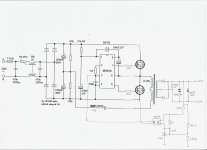hello!
i ordered a couple of IR2153 because its a simpler implement for halfbridge vs TL494 or SG3525 but i noticed theres no error comparator/amplifier and most designs are just free oscillating/unregulated design. is there any way to implement voltage correction/feedback for this IC?
looking at the datasheet shutdown is achieved by shunting pin3(CT) to ground which i think interrupts the internal oscillator.
can it be used for feedback using an optocoupler?
wouldnt that leave one of the switches in the "ON" state?
thanks.
i ordered a couple of IR2153 because its a simpler implement for halfbridge vs TL494 or SG3525 but i noticed theres no error comparator/amplifier and most designs are just free oscillating/unregulated design. is there any way to implement voltage correction/feedback for this IC?
looking at the datasheet shutdown is achieved by shunting pin3(CT) to ground which i think interrupts the internal oscillator.
can it be used for feedback using an optocoupler?
wouldnt that leave one of the switches in the "ON" state?
thanks.

